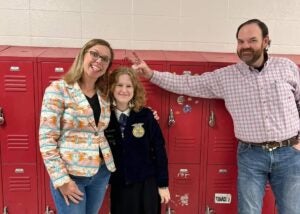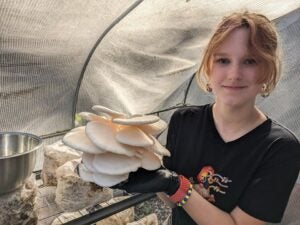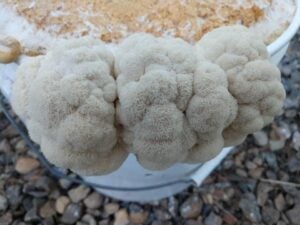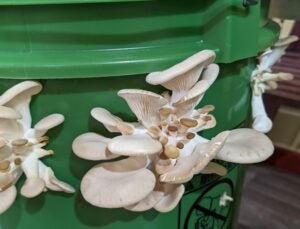Many projects come to mind when you hear about FFA and SAEs, but fungus isn’t typically one of them. This funky project, however, is central to one Arkansas high school student, Alaina Reeves, a hardworking entrepreneur who has turned her passion for growing mushrooms into a business with plans that extend far beyond the bags and five-gallon buckets that often line her home and greenhouse.
While Reeves’ FFA experiences began in the eighth grade, she got her taste for mushrooms at the family dinner table years prior. Last year, Reeves earned a state award as part of the Rison High School FFA Chapter while raising chickens and a small garden. Her goals broadened with encouragement from her FFA advisors, expanding to what is now Gnome Home Farms, with the goal of earning an American All-Star Degree and an Ag Proficiency Award.
»Related: When an FFA advisor’s philosophy of life sticks with you
“I wasn’t very confident in the beginning, but my SAE teachers pushed me to just do it. They’re always there to help me, and they’re so supportive of my projects,” Reeves said.

Gnome Home Farms isn’t just about mushrooms, though. Reeves still raises chickens and sells eggs, canned goods, and micro greens. Reeves also has a home dog grooming business — leaving one to wonder — just when does she sleep?
In 2020, Reeves began growing mushrooms as a hobby. After researching best practices for over two years, she started her business in February 0f 2022. She aims to turn her small enterprise into a farm-to-table agritourism experience complete with — you guessed it — mushrooms.
It’s not all easy — her family calls their farming “bougie farming,” some of Reeve’s low-tech methods are work-intensive, and when a crop fails or something goes wrong, it provides funding challenges. Mushroom farming also requires intensive cleaning — because they’re a fungus, Reeves’ crops are easily contaminated by mold and can even cross to make undesirable hybrids.

Reeves currently grows snow oyster, blue oyster, pink oyster, and lion’s mane mushrooms for markets. Her mushrooms are available to customers through her online store, but she also sells regularly to the local country club, where the chef uses her products — primarily oyster varieties — marinated as a charcuterie board centerpiece.
“My favorite type of mushroom that I grow is the lion’s mane, I haven’t had much luck with those, but they’re so much fun to watch grow,” said Reeves.

Beyond farming, Reeves is an active participant in agricultural events, including attending cattlemen’s conferences, the National FFA Convention, and presentations by Temple Grandin, as well as giving her own talk on easy ways to grow mushrooms at home at the Arkansas Homesteading Conference.
“I’ve grown through FFA, it’s taught me how to get out of my comfort zone, and taught me about public speaking. Now, I’m teaching and learning about leadership. I’ve gotten a lot more confident through FFA,” said Reeves.
Reeves shares that the easiest way to grow mushrooms at home is the bucket method. First, you have to create the substrate — hay or straw is recommended for beginners. It has to be pasteurized with boiling water and left to sit for two hours. Reeves recommends using an ice chest.

After draining, the substrate can be added to buckets with drilled holes by layering it with grain spawn to begin colonization. Excrement by the mushrooms (a brown liquid called metabolites) will build up, so make sure that you have a liner underneath the mushrooms, so the “mushroom poop” can be easily cleaned up.
You can continue to follow Reeves’ journey through her social media. If you’re looking to turn your passion into an SAE project, make sure to check with your FFA advisor — there are few limits to ways students can apply classroom principles while exploring careers, networking, and more.
Heidi Crnkovic, is the Associate Editor for AGDAILY. She is a New Mexico native with deep-seated roots in the Southwest and a passion for all things agriculture.



